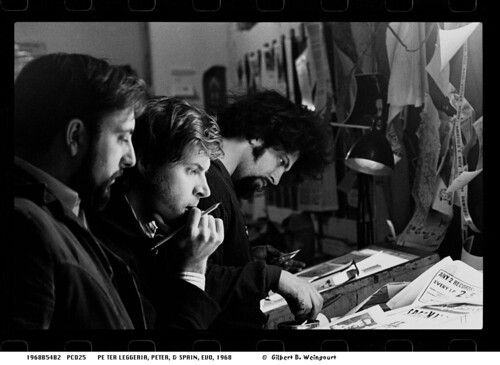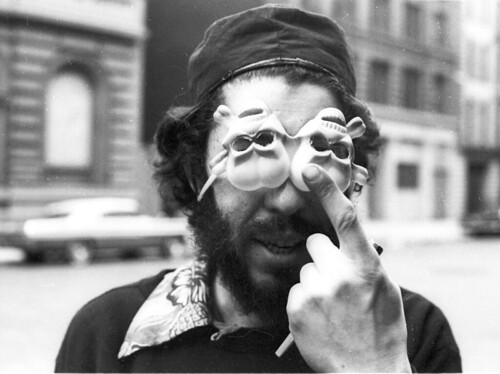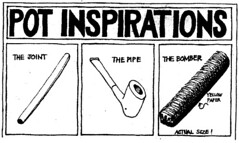Earlier this week, the Arthur L. Carter Journalism Institute launched “Blowing Minds: The East Village Other, the Rise of Underground Comix and the Alternative Press, 1965-72,” with a rousing discussion that’s now archived on the exhibit’s Website, along with new audio interviews with veterans of the Other. Over the course of seven weekend editions of The Local, we’ve heard from all but one of the EVO alumni who spoke on Tuesday’s panel. Here now, to cap off our special series, is the story of Peter Leggieri.
 Gil Weingourt Left to right: Peter Leggieri, Peter Mikalajunas, and Spain Rodriguez.
Gil Weingourt Left to right: Peter Leggieri, Peter Mikalajunas, and Spain Rodriguez.From the first day that I began working at The East Village Other, I was overcome by the sense that it was not only a newspaper but a strange and magical ship on a voyage with destiny. It seemed as though each issue printed was a new port of call, and the trip from one issue to the next, a new adventure. Many of EVO’s crew members expressed that same weird feeling – a sense of excitement and creative power.
And what a crew that was! No one was recruited. I don’t recall a resume ever being submitted. They all simply showed up and started working. EVO’s crew might just have been the greatest walk-on, pick-up team in the history of journalism. She was The Other but her staff of artists, poets, writers, photographers and musicians affectionately called her EVO. Her masthead bore a Mona Lisa eye. EVO created a cultural revolution and won the hearts and minds of a generation. She was the fastest ship in the Gutenberg Galaxy.
In the Beginning
I was the anonymous Other, the one editor-owner unknown to the public. I did not party. I did not schmooze with the literati or seek publicity. I had no time for such things. I worked seven days a week, 20 hours a day and, because of law school, I had to be sober. My friend, the poet John Godfrey, told me that I was afflicted with a Zen curse: a hermit condemned to be surrounded by people and events. That was certainly the case for me in the 1960s. Read more…
 Bob Simmons Tuli Kupferberg
Bob Simmons Tuli KupferbergThe funniest part of reminiscing about the uber-subversive East Village Other for The New York Times is that the latter set me on the road to rebellion before the former was even founded in 1965. I’m told I was reading by age four and within a few years the first section I grabbed when the Sunday Times arrived every weekend was the Book Review. The Grove Press ads kidnapped my imagination: Who was this Alain Robbe-Grillet guy and how do you pronounce his name? Why was William Burroughs considered so dangerous and did his characters have meals while wearing no clothes? And speaking of clothes, how come the girls on Grove’s covers wore so little?
Obviously my nascent libido was ready for plucking, but my fascination was not simply sexual. I wanted to know why in the land of the First Amendment some had wanted to ban these books.
I bought my first issue of the Village Voice in February 1966; it contained an obituary of the abstract expressionist Hans Hofmann. Already a Dylan fan, I scanned the ads for folk clubs and was absolutely smitten by bohemia. The first girl who won my heart in elementary school was Jessica Hentoff (I don’t recall my feelings being reciprocated) and her father Nat wrote for the Voice. Soon I picked up the Voice’s competitor, The East Village Other.
No friends’ parents wrote for EVO. Scruffier, funnier and dirtier than the Voice, EVO was not simply about bohemia, it was an anarchist’s bomb in newsprint hurled at the bourgeoisie. Even at my tender age, I knew that I didn’t like the world that grown-ups had created. The troublemakers at The Other were expressing themselves in ways I could only daydream about at that point. Read more…
 Detail from an illustration by Bill Beckman.
Detail from an illustration by Bill Beckman.I came to EVO in late 1965. I think the paper was about three issues old. Walter Bowart had quit his job as a bartender at the Dom on St. Marks Place (Ed Sanders says it was Stanley’s, maybe it was both) and had raised some money to publish what he was soon to become fond of calling “a hippie National Inquirer.” (“Hippies don’t like to read. They like pictures and big headlines.”) I had just come to New York City from Texas. At the time I wasn’t sure if I wanted to make it uptown or downtown. All that was certain was that I needed to get some kind of employment.
I was living in the basement of Bill and Debbie Beckman’s apartment on East Ninth Street between Avenues C and D. At the time, this was decidedly a sketchy neighborhood, populated by young Puerto Rican street entrepreneurs who would have duels with ripped-off car antennae, whipping each other viciously over turf or girlfriends or whatever. The old mittel Europeans, Ukrainians, and refugees who lived in the ratty tenements would scurry to get out of their way as they crossed Houston to get a knish. It would have been maybe December of 1965 when I arrived. It was shaping up as a very cold winter, with an incredible blizzard that happened just a few weeks after my arrival. Being a naive Texan, I had innocently driven my car and tried to keep it on the streets. I lost it for almost 10 days under the snow. It was all very new to me. Snow. Hippies. The East Village Other. Read more…
 Steve Kraus
Steve KrausAs documented in a DNA Info video, Steve Kraus has been publishing the New York Good News since the 1960s. Now 82, he has lived just above Café Mogador on St. Marks Place for the past 37 years. He also volunteers for the Jewish Foundation of the Righteous. The following piece appeared in a 1979 booklet produced by the Alternative Press Syndicate, titled “Alternative Media: How the Muckrakers Saved America,” published by Bell and Howell. It is reprinted here with the author’s permission.
Steve Kraus – How Green Was My Underground
For more on “Blowing Minds: The East Village Other, the Rise of Underground Comix and the Alternative Press, 1965-72,” read about the exhibition here, and read more from EVO’s editors, writers, artists, and associates here.








